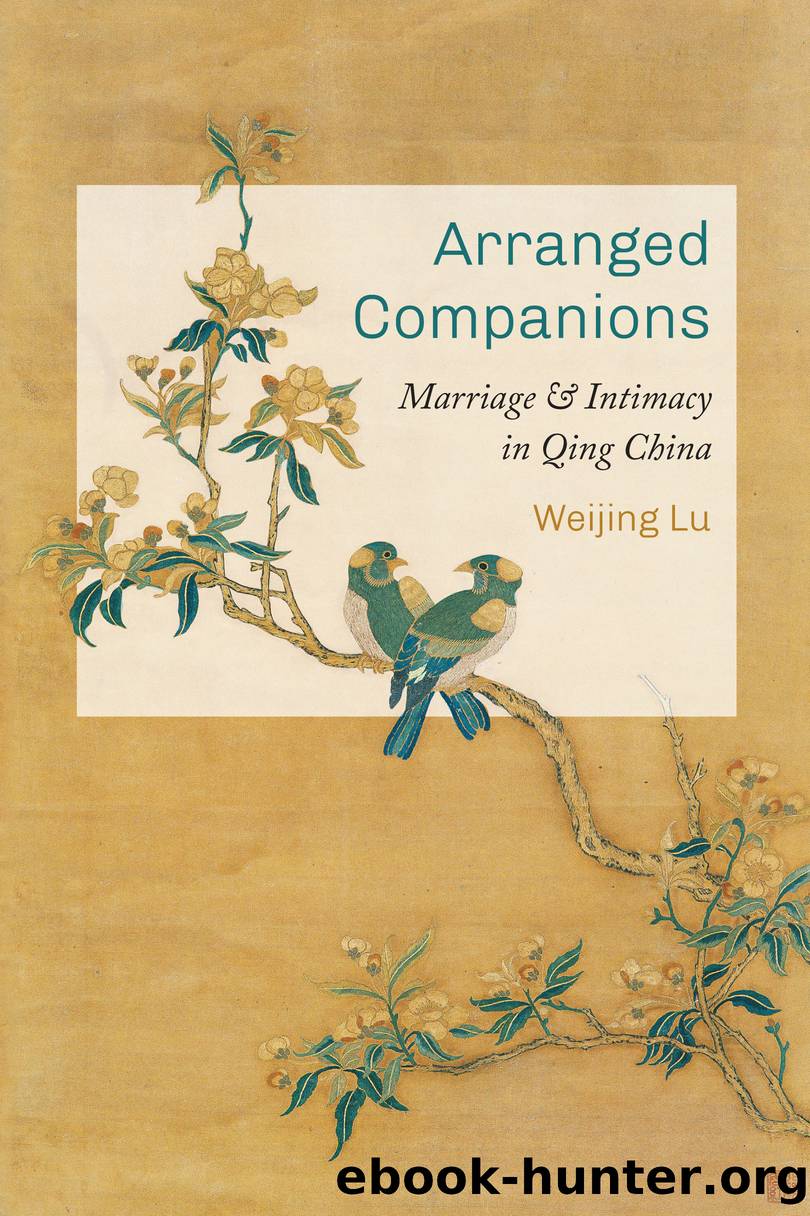Arranged Companions by Weijing Lu;

Author:Weijing Lu;
Language: eng
Format: epub
Publisher: University of Washington Press
Remedying Marital Problems
Given the importance of preserving family harmony for the sake of prosperity, elders would do all they could to bring marital discord under control. For a seriously troubled marriage that involved a concubine, one solution was to arrange for the wife to live separately while leaving the husband and his concubine in the main house, a practice that had already existed in the Ming.70 The wifeâs domicile would be supported by the immediate family of the husband if not the husband himself. In Zhang Lüxiangâs daughterâs case, both sides had considered the idea and she agreed to âmove out to live in a separate room,â but it did not work out.71
Although the marital family had the most to lose when problems escalated, the husbandâs relatives were often unable, disinterested, or ineffective in addressing conflicts. Some didnât have the ability to intervene, and jealous or selfish relatives would not want to. And relatives could be biased, as seen in Zhangâs daughterâs case. Those who believed that fraternal relationships took precedence over husband-wife relationships might not do everything they could to help. A relationship crisis exposed a deep fissure between a married womanâs identity and her emotional status with her marital family. The patrilineal principle tied a married woman firmly to her husband and his lineage. Upon marriage, she became a full member of her marital family, a ritual equal to her husband, and an ancestor of the family upon death. Nevertheless, that identity did not necessarily guarantee respectable treatment, especially for young wives.
If a marital crisis revealed a weak link between a married woman and her marital family, it also demonstrated a married daughterâs unbroken ties with her natal home.72 The natal family could be a reliable safe haven for an unhappily married daughter so long as it had the means to support her. Distraught young wives enduring many kinds of hardships and crisesâsickness, widowhood, poverty, or abuseâcould return to their parents for some time. To give another example, Fang Baoâs married sister returned because of poverty and looked after their ailing mother. Fang would give grain to her husband and concubine monthly to help their livelihood.73 Natal families not only took in married daughters in distress, some even accepted an abusive son-in-law into their homes or made arrangements for him, as we have seen in some of the cases mentioned earlier. The customary practice of a married daughter relying on her natal family for support in times of need sheds an important light on the workings of the patrilineal system, which would have had a hard time sustaining itself without help from affinal kin.
According to the Qing law, divorce could be granted if âhusband and wife are disharmonious and both agree to be separated,â and divorce must be enforced if either husband or wife committed a crime involving beating or killing the relatives of the other party. The law also incorporated the ritual prescriptions for divorcing a wife and for protecting her from being divorced, the so-called qichu and san buqu.
Download
This site does not store any files on its server. We only index and link to content provided by other sites. Please contact the content providers to delete copyright contents if any and email us, we'll remove relevant links or contents immediately.
How to Be a Bawse: A Guide to Conquering Life by Lilly Singh(7156)
Spare by Prince Harry The Duke of Sussex(4788)
Millionaire: The Philanderer, Gambler, and Duelist Who Invented Modern Finance by Janet Gleeson(4099)
Machine Learning at Scale with H2O by Gregory Keys | David Whiting(3627)
Harry Potter 02 & The Chamber Of Secrets (Illustrated) by J.K. Rowling(3556)
Never by Ken Follett(3528)
The Heroin Diaries by Nikki Sixx(3320)
Urban Outlaw by Magnus Walker(3242)
Harry Potter and the Prisoner of Azkaban (Book 3) by J. K. Rowling(3109)
Japanese Design by Patricia J. Graham(3000)
Fairy Tale by Stephen King(2949)
The Man Who Died Twice by Richard Osman(2808)
The Club by A.L. Brooks(2747)
Stacked Decks by The Rotenberg Collection(2687)
Will by Will Smith(2580)
Harry Potter and the Deathly Hallows (7) by J.K. Rowling(2550)
Churchill by Paul Johnson(2364)
The Chimp Paradox by Peters Dr Steve(2225)
Borders by unknow(2117)
